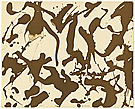Pollock + Krasner
Abstract Expressionism is the term used to describe the gestural abstraction that dominated painting after World War II. The style emphasises spontaneity and intuition, and was not based in the geometry that had underpinned much earlier abstract art. Jackson Pollock and Lee Krasner are two of the painters most closely associated with Abstract Expressionism. Their work captures the rebelliousness and emotional intensity of this period.
Pollock assimilated aspects of indigenous cultures into his work. Totem lesson 2 1945, and some of his early drawings, reflect the contemporary enthusiasm for American Indian art. The ritual practice of sand images, according to the artist, was a factor that led to his drip works, painted on canvases laid flat on the floor. Blue poles 1952 reveals Pollock’s expressive spontaneity, which allowed him to bypass the constraints of Western artistic tradition.
Krasner was a mature artist when she and Pollock met in 1941; they married in 1945. She had studied under Hans Hofmann in the late 1930s, establishing a strong reputation as a colourist. Krasner often recycled her earlier drawings as collage and her magnificent Untitled 1953, with its rich blacks and layered textures, exemplifies this approach. Later, she began to develop similar forms and shapes in large monochrome paintings and, finally, mural-sized works.




